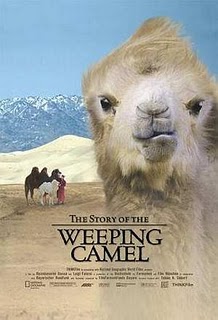The Story of the Weeping Camel
The Story of the Weeping Camel Mongolian , Ingen nulims , Tears of the Camel is a 2003 German docudrama distributed by ThinkFilm. It was released internationally in 2004. The movie was directed and written by Byambasuren Davaa and Luigi Falorni. The plot is about a family of nomadic shepherds in the Gobi Desert trying to save the life of a rare white bactrian camel Camelus bactrianus calf after it was rejected by its mother.
To restore harmony between the mother and calf, the nomadic family call upon the services of group of lamas who perform a ritual with bread or dough effigies Standard Tibetan torma of the mother, the calf and the individual members of the family. The rite opens with the sound of a sacred conchshell horn followed by bells in the hands of lamas, some of whom wield vajra. The rite takes place with members of the extended nomadic community and a number of lama at a sacred place that consists of one end of a log, or wooden pole, set in the earth, with the other end raised to the sky a stylized victory banner Sanskrit Dhvaja with a piece of blue fabric entwined around it, functioning as a prayer flag darchorstyle. The log is supported by a cairn of rocks at its base as foundation. The ritual, however, does not reestablish harmony between the mother and calf.The family then resolve to secure the services of an indigenous violinist to play the music for a Mongolian Hoos ritual. They send their two young boys on a journey through the desert to the community marketplace to locate a musician. The violinist who plays more precisely a morin khuur is summoned to the camp and a ritual of folk music and chanting is enacted. The musician first drapes the morin khuur on the first hump of the camel to establish a sympathetic magical linkage between the mother and the state of harmony represented by the instrument. Once this is done he removes the instrument and commences playing. As the musician sounds the Mongolian violin, the female family member who lulled her child to sleep with a lullaby earlier in the documentary, repeatedly intones the calming sounds and beautiful melody of the hoos. At this point, the mother camel starts to weep, tears visibly streaming from her eyes. Immediately after the rite the mother and calf are reconciled and the calf draws milk from her teat. ........
Source: Wikipedia

